TV Signal Strength Meter / Antenna Alignment Meter & How to Use It
A TV antenna or aerial signal strength meter can be very useful for checking for the best TV station signals and aligning TV antennas.
Home » Antennas & Propagation » this page
TV antennas guides include:
Types of TV antenna
Buying a TV antenna
TV antenna direction alignment & pointing
TV transmitter finder app
TV antenna alignment meter
Buying TV antenna amplifier / booster
Indoor TV antenna & set-up
Satellite TV dish installation
How to wire a TV antenna socket
Why doesn't a TV antenna work any more
General antenna installation guides
Antenna installation guide
Attic installation
Antenna height
Having a TV aerial or antenna alignment meter or as they are also called a TV signal strength meter or tester provides an excellent indication of the TV signal strength and be an essential part of the installation of a TV antenna whether terrestrial, digital, satellite, etc.
Even though it may be possible to obtain the direction from looking at other TV antennas in the locality, having a signal strength meter enables the signal to be optimised for the particular location.
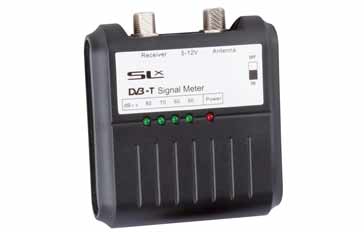
Some televisions may have a signal strength indicator in the set up settings, these are not easy to use. Some may only give the strength indications when setting up the channels, others may have a strength indication present, but whatever the actual presentation, they are not at all easy to use on a varying signal level.
Trying to set up and align or orientate a television antenna by looking at other antennas, or even using a TV transmitter finder app may not always provide the best alignment.
This is because transmitters have different power levels, the terrain between the transmitter and the receiver may not give a clear path. The TV signal strength meter or tester will indicate the direction of the best signal whether it seems an acceptable distance away or not.
The signal can also be obstructed by tall buildings or hills and signals may be reflected making the strongest signal come from a slightly different direction to that which might be expected.
While these meters or testers are widely used for setting up the TV antennas for permanent home installations, they can also be used for orientating the antennas used with mobile homes, boats and the like as they move from one location to another.
Having a low cost TV signal strength meter or alignment meter enables the optimum signal to be obtained very quickly when setting up in a new amp site, mooring or other location.
The need to accurate alignment
Modern television antennas are designed to provide gain, but this comes at the expense of a reduction in sensitivity in other directions.
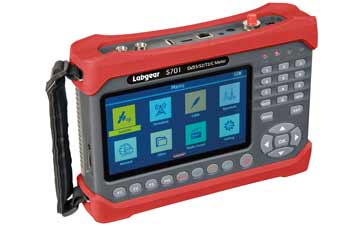
This can be useful because it reduces the possibility of interference from other stations, but it does mean that the TV antenna needs to be reasonably accurately orientated towards the transmitter.
The higher the gain of the antenna, the more directional it becomes, and hence the need for accurate orientation of alignment increases with the increased gain.
The sensitivity or gain of an antenna can be shown on what is called a polar diagram - the greater the distance the line is from the centre origin, the greater the sensitivity or gain.
The polar diagram in the diagram is shown for a typical TV antenna - one of the most common types is called the Yagi antenna.

It can be seen that the maximum gain occurs towards the right hand side of the diagram - along the axis of the antenna away from what is called the reflector, although there are a few spurious "lobes" which normally do not cause an issue.
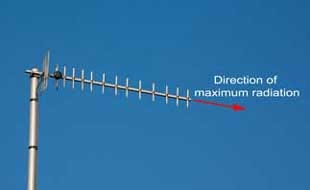
Although other types of TV antenna can be used - one of the more common alternatives might be a log periodic antenna - the same basic principles hold true whether for this or any other type of TV antenna.
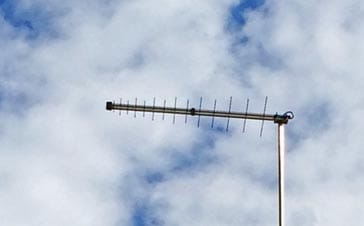
What is a TV signal strength meter
One of the ways of aligning a TV antenna is to use a signal strength meter or TV signal strength tester. These units are essentially small radio receivers that receive the television signals from the antenna and then indicates an overall signal strength.
The receivers often cover the whole band: either terrestrial or satellite, depending on the meter. Some may cover terrestrial transmissions and other satellite transmissions or both.
By maximising the strength indication it is possible to orientate the antenna so that it receives the maximum signal strength.
As these meters are relatively small and very portable, they can be connected to the television coax feeder very easily - they typically have Type F connectors so they can easily interface with a large number of TV leads. It is also possible to get adapters if the right connectors are not available.
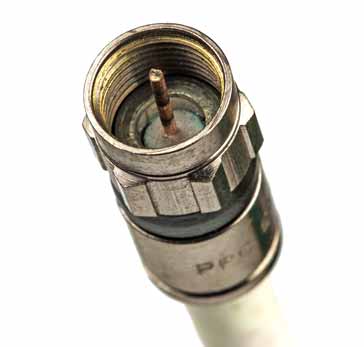
Although the professional signal strength / antenna alignment meters give a good strength reading and they enable a large number of parameters to be monitored, the low end ones are quite basic and cover the whole band for the whole band, and often the strength indications are relatively crude, although just enough to align the TV antenna.
How to buy the best TV signal strength / antenna alignment meter
There are many different meters on the market, some of which are very cheap costing around $20, £20 or thereabouts, and others are much more expensive costing over $100 or more. Some may even be $500 or more.
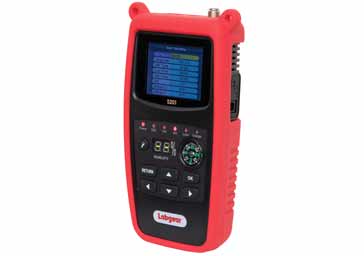
As there is such a large variation between the low end meters and those at the high end of the market, it is necessary to make a judgement about what exactly is needed and how much it is worth spending.
Here are a few pointers about some parameters to look for.
Satellite or terrestrial: Antenna alignment meters can be used for aligning either satellite or terrestrial television. As these two types of television broadcast use very different frequencies, it is necessary to ensure that the alignment meter is able to work for the required type of television reception.
Some work for both, but these are mainly the higher end professional ones. The smaller ones for domestic use will only be for either terrestrial television or satellite television, so it is essential to select one for the antenna and type of reception.
Frequency coverage: Even when the required type of meter has been selected, i.e. terrestrial or satellite, it is worth checking that it covers the required band. This is particularly true in countries like the USA where UHF and VHF are used for terrestrial television.
Cost: Cost is a significant issue when buying one of these TV antenna alignment meters. If it is required for a single antenna installation then there is no point in spending hundreds of pounds, dollars, Euros, etc.
But if it is required for someone installing TV antennas professionally, then a more expensive meter that is easier to use is a good investment. A judgement needs to be made according to what is needed.
How to align a TV antenna using a signal strength meter
The way an TV antenna alignment meter is used will depend greatly upon the type of meter, so it is always best to read the instructions to find out how the meter works and how it should be used.
It is worth first looking at how one of the low cost meters might be used.
Pre-align TV antenna: It is always worth pre-aligning the TV antenna in the direction which might be expected to give the best signal. This can be done by looking at other nearby antennas or by using a TV transmitter finder app for a smartphone.
Connect power: These meters tend to be powered by an external battery - often anywhere between 5 volts and 12 volts is used, but check the specification and instructions.
The power may be connected to the unit, either via an F-type antenna socket, or via a miniature jack or other similar connector. Ensure that the polarity is correct.
Turn meter on: There will normally be a switch to turn the power on. When it is on, there will often be an LED power indication which will illuminate.
Connect the antenna down-lead to the meter: With the meter on and the antenna connected a reading is likely to be obtained. The indicator may be a series of LEDs or sometimes an analogue meter.
Rotate antenna: Once the initial reading has been obtained, the antenna can be rotated to give the maximum signal strength. When any measurements are being made, ensure that nobody is near the antennas they may cause reflections, or alter the properties of the antenna if they are very close.
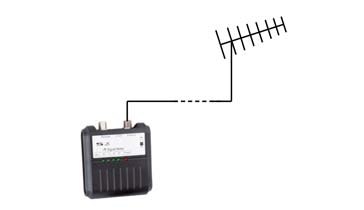
Typical TV antenna alignment setup Adjustment decisions: If there is more than one signal peak, this cold be that signals are received from two different transmitters and the optimum one should be chosen - this may be the strongest signal, or it may correspond to the channels or stations that are to be received.
Check reception on the TV: The final test is to check that the television works satisfactorily with the antenna installation and alignment.
There are meters which are more complicated and these require a more sophisticated set-up routine.
These often require further set up before they are sued. Often they may be dual satellite / terrestrial which need to be selected along with other parameters such as the channel, whether a pre-amplifier is sed and what the drive voltage might be.
For satellite, again the satellite band, and other parameters including the antenna polarisation the voltage to power the LNB and other items as well.
These all need to be set, but once this has all been done, the basic steps are still the same as for the simple antenna alignment meter.
However for the additional cost, the more sophisticated meters will give much better results and possibly enable a better level of alignment or orientation to be achieved.
TV signal meter measurements
There are many different measurements that can be made by a TV antenna alignment or signal strength meter.
The actual measurements that can be made will depend upon the signal strength meter in question - obviously the entry level ones will have very few, but those that are more sophisticated will be able to make more.
It is sometimes useful to understand what measurements can be made.
Signal strength: The signal strength indication is the one found on even the basic meters. It gives the strength and peaks can be seen so that the antenna can be adjusted to give the peak signal.
Some meters may also have figures associated with the reading and these are likely to be calibrated in dBµV. This is a reading of the signal strength in decibels relative to one microvolt. Typically between 50 and 65 will give a good picture.
Modulation Error Ratio, MER: The MER is a commonly used indication of the signal quality. It takes into account the signal strength and all the interference on the transmission channel. For good TV reception, a figure of at least 25 dB is recommended.
Bit Error Rate, BER: The bit error rate is another measure of the signal quality. It details the number of bit errors occurring and it is normally expressed as a percentage. The more errors that occur, the poorer the signal quality and the grater the chance of pixellation on the displayed picture. Bit errors occur as a result of low signal level and the interference, noise, and distortion that occur.
All TV alignment and signal strength meters will give some indication of the signal level so that the TV antenna can be correctly orientated. It is only the more comprehensive professional signal strength meters that will give the indications of signal quality and other measurements.
For most domestic signal installation, or TV antennas for mobile homes, etc, a simple meter may often suffice.
Using a TV antenna alignment meter provides the best way of ensuring the optimum TV reception is obtained. Whether using terrestrial or satellite signals, an alignment or orientation meter will ensure that the antenna is pointing in the right direction to obtain the best signals. In this way interference will be reduced and fewer problems will be encountered.
 Written by Ian Poole .
Written by Ian Poole .
Experienced electronics engineer and author.
More Antenna & Propagation Topics:
EM waves
Radio propagation
Ionospheric propagation
Ground wave
Meteor scatter
Tropospheric propagation
Antenna basics
Cubical quad
Dipole
Discone
Ferrite rod
Log periodic antenna
Parabolic reflector antenna
Phased array antennas
Vertical antennas
Yagi
Antenna grounding
Installation guidelines
TV antennas
Coax cable
Waveguide
VSWR
Antenna baluns
MIMO
Return to Antennas & Propagation menu . . .



